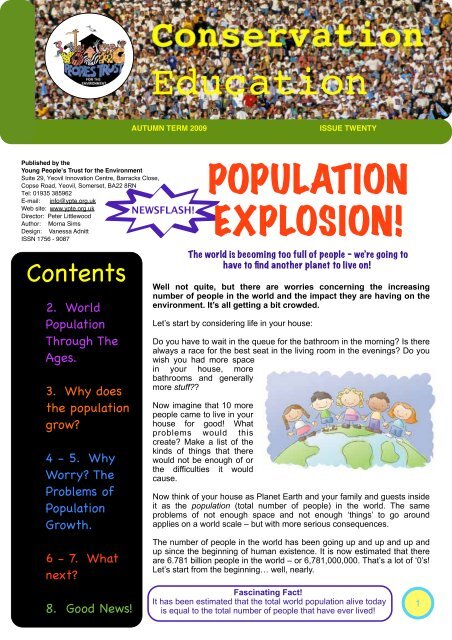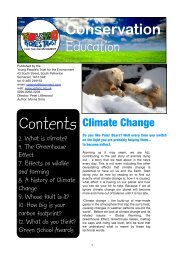Population Explosion - Young People's Trust for the Environment
Population Explosion - Young People's Trust for the Environment
Population Explosion - Young People's Trust for the Environment
Create successful ePaper yourself
Turn your PDF publications into a flip-book with our unique Google optimized e-Paper software.
Education<br />
AUTUMN TERM 2009 ISSUE TWENTY<br />
Published by <strong>the</strong><br />
<strong>Young</strong> Peoples <strong>Trust</strong> <strong>for</strong> <strong>the</strong> <strong>Environment</strong><br />
Suite 29, Yeovil Innovation Centre, Barracks Close,<br />
Copse Road, Yeovil, Somerset, BA22 8RN<br />
Tel: 01935 385962<br />
E-mail: info@ypte.org.uk<br />
Web site: www.ypte.org.uk<br />
Director: Peter Littlewood<br />
Author: Morna Sims<br />
Design: Vanessa Adnitt<br />
ISSN 1756 - 9087<br />
NEWSFLASH!<br />
POPULATION<br />
EXPLOSION!<br />
<br />
<br />
<br />
<br />
Contents<br />
2. World<br />
<strong>Population</strong><br />
Through The<br />
Ages.<br />
3. Why does<br />
<strong>the</strong> population<br />
grow<br />
<br />
4 - 5. Why<br />
Worry The<br />
Problems of<br />
<strong>Population</strong><br />
Growth.<br />
6 - 7. What<br />
next<br />
8. Good News!<br />
The world is becoming too full of people - we’re going to<br />
have to find ano<strong>the</strong>r planet to live on!<br />
Well not quite, but <strong>the</strong>re are worries concerning <strong>the</strong> increasing<br />
number of people in <strong>the</strong> world and <strong>the</strong> impact <strong>the</strong>y are having on <strong>the</strong><br />
environment. It’s all getting a bit crowded.<br />
Let’s start by considering life in your house:<br />
Do you have to wait in <strong>the</strong> queue <strong>for</strong> <strong>the</strong> bathroom in <strong>the</strong> morning Is <strong>the</strong>re<br />
always a race <strong>for</strong> <strong>the</strong> best seat in <strong>the</strong> living room in <strong>the</strong> evenings Do you<br />
wish you had more space<br />
in your house, more<br />
bathrooms and generally<br />
more stuff<br />
Now imagine that 10 more<br />
people came to live in your<br />
house <strong>for</strong> good! What<br />
problems would this<br />
create Make a list of <strong>the</strong><br />
kinds of things that <strong>the</strong>re<br />
would not be enough of or<br />
<strong>the</strong> difficulties it would<br />
cause.<br />
Now think of your house as Planet Earth and your family and guests inside<br />
it as <strong>the</strong> population (total number of people) in <strong>the</strong> world. The same<br />
problems of not enough space and not enough ‘things’ to go around<br />
applies on a world scale – but with more serious consequences.<br />
The number of people in <strong>the</strong> world has been going up and up and up and<br />
up since <strong>the</strong> beginning of human existence. It is now estimated that <strong>the</strong>re<br />
are 6.781 billion people in <strong>the</strong> world – or 6,781,000,000. That’s a lot of ‘0’s!<br />
Let’s start from <strong>the</strong> beginning… well, nearly.<br />
Fascinating Fact!<br />
It has been estimated that <strong>the</strong> total world population alive today<br />
is equal to <strong>the</strong> total number of people that have ever lived!<br />
1
World <strong>Population</strong> Through The Ages -<br />
The Numbers.<br />
In 10,000 B.C. <strong>the</strong> world population was around 1 million (1,000,000). These people were known as ‘hunter ga<strong>the</strong>rers’<br />
because <strong>the</strong>y lived very simply, by hunting animals <strong>for</strong> food and ga<strong>the</strong>ring nuts, berries, fruits and o<strong>the</strong>r food from <strong>the</strong><br />
woodlands and moorlands. They didn’t live in one place all <strong>the</strong> time; instead <strong>the</strong>y moved around from place to place to<br />
find food. Their impact on <strong>the</strong> environment was small and any damage <strong>the</strong>y caused was temporary – <strong>the</strong> land recovered<br />
once <strong>the</strong>y moved on.<br />
By <strong>the</strong> year 0 A.D. (10,000 years later) <strong>the</strong> world population had increased<br />
slowly to 200 million. By now people were settled in towns and villages and<br />
had started to grow <strong>the</strong>ir own food on basic farms. They would have cut<br />
down trees to clear <strong>the</strong> land <strong>for</strong> building <strong>the</strong>ir houses on and to create<br />
fields <strong>for</strong> growing <strong>the</strong>ir crops and rearing <strong>the</strong>ir animals. But <strong>the</strong>ir impact on<br />
<strong>the</strong> environment was still low.<br />
The numbers continued to creep up until <strong>the</strong> 1800s. Look at <strong>the</strong> dates and<br />
figures below:<br />
Date <strong>Population</strong><br />
10,000B.C. 1 million (1,000,000)<br />
0 A.D. 200 million<br />
1500 A.D. 500 million<br />
1810 A.D. 1,000 million (1 billion – 1,000,000,000)<br />
1950 A.D 2,406 million<br />
1999 A.D 6,000 million (6 billion – 6,000,000,000)<br />
2009 A.D 6,781million<br />
These numbers are much easier to understand on a graph:<br />
So it took thousands and thousands of years, from human prehistory right through to <strong>the</strong> early 1800s <strong>for</strong> <strong>the</strong> world<br />
population to reach it’s first billion.<br />
Then came <strong>the</strong> start of a sudden population increase. The second billion was added in little more than<br />
100 years, and <strong>the</strong> 3 rd billion was reached less than 50 years later, in <strong>the</strong> 1960s. The 4 th , 5 th and 6 th<br />
billion people were reached in spans of only about 12 years each! And from now on we can expect<br />
54 million more people on <strong>the</strong> planet per year – that’s 149,000 people per day or 2 or 3 football<br />
stadiums’ worth!<br />
If you visit http://www.ibiblio.org/lunarbin/worldpop you will find a counter that shows just how<br />
fast <strong>the</strong> population is growing. It shows that <strong>the</strong> world’s population grows by 3 people<br />
EVERY SECOND!<br />
<strong>Population</strong> growth = <strong>the</strong> number of babies born minus <strong>the</strong> number of people dying.<br />
2
Why does <strong>the</strong> population grow<br />
The main reason <strong>for</strong> <strong>the</strong> huge spurts in<br />
population growth is that people began to<br />
live a lot longer. This was due to<br />
improvements in medical treatments as<br />
well as improved living conditions.<br />
Technology suddenly improved, with <strong>the</strong><br />
‘Industrial Revolution’ in <strong>the</strong> 1800s.<br />
Tractors replaced horses and machines<br />
replaced people so it became much easier<br />
to grow lots of food and to transport it from<br />
place to place. Clean, fresh water was<br />
much more readily available. More and<br />
more babies were being born and surviving<br />
into adulthood so towns grew into cities<br />
and more new towns and villages were built.<br />
Un<strong>for</strong>tunately some places (<strong>for</strong> example several African countries) don’t enjoy this modern technology or decent medical<br />
services. But <strong>the</strong>se less developed countries still have an increasing population (<strong>the</strong>re are more babies being born each<br />
year than <strong>the</strong>re are people dying). In fact <strong>the</strong> highest population growth rates are in <strong>the</strong> least developed countries of <strong>the</strong><br />
world.<br />
But <strong>the</strong> population isn’t growing in all countries ei<strong>the</strong>r. In Italy, <strong>for</strong> example, <strong>the</strong> population is going down because people<br />
are having fewer babies; each year <strong>the</strong>re are more people dying (in old age mainly) than <strong>the</strong>re are babies being born.<br />
It is difficult to predict how many people will be living on <strong>the</strong> planet in <strong>the</strong> future but scientists believe that by 2025 <strong>the</strong><br />
world population will be around 8 billion people and that it could reach 10 billion (10,000,000,000) by 2050 – eek!<br />
Only when <strong>the</strong> birth rate is <strong>the</strong> same as <strong>the</strong> death rate will <strong>the</strong> population of <strong>the</strong> world stop growing. It is estimated that<br />
this won’t happen until <strong>the</strong> total population reaches 10 billion. Meanwhile our planet is becoming ra<strong>the</strong>r crowded.<br />
Needs Must!<br />
The problem is that everyone on <strong>the</strong> planet needs <strong>the</strong> essentials <strong>for</strong> survival:<br />
<br />
<br />
<br />
<br />
<br />
somewhere to live,<br />
food to eat,<br />
clean fresh water to drink and cook with,<br />
clo<strong>the</strong>s to wear,<br />
places to work, learn, play and travel.<br />
And we also want as many of <strong>the</strong> not-so-essential ‘luxury’ items as possible:<br />
<br />
<br />
<br />
<br />
cars,<br />
toys and games,<br />
electrical appliances like fridges, hair dryers, TVs, iPods,<br />
cameras, mobile phones,<br />
books, furniture, etc.<br />
Where do all <strong>the</strong>se things come from Absolutely everything in our lives<br />
originally comes from our surrounding environment: <strong>the</strong> bricks <strong>for</strong> <strong>the</strong><br />
buildings, <strong>the</strong> fabrics <strong>for</strong> our clo<strong>the</strong>s, <strong>the</strong> food we eat and <strong>the</strong> water we<br />
drink; paper <strong>for</strong> books; metals and plastic <strong>for</strong> mobile phones and TVs;<br />
power supplies <strong>for</strong> <strong>the</strong> electrical appliances. These things are known as<br />
resources or raw materials.<br />
There are now so many people in <strong>the</strong> world that we are starting to<br />
compete <strong>for</strong> resources such as oil, food and building materials – and we<br />
are starting to run out of some of <strong>the</strong>m. This is putting pressure on <strong>the</strong><br />
environment and causing serious problems in some parts of <strong>the</strong> world.<br />
The world’s population is concentrated more and more in<br />
towns and cities. In many less developed countries of Asia,<br />
Africa and Latin America, many of <strong>the</strong>se cities are overcrowded because people move <strong>the</strong>re from <strong>the</strong><br />
countryside in search of food, shelter and jobs. 3
Why Worry The Problems of<br />
<strong>Population</strong> Growth<br />
There are a number of problems created when too many people try to live in<br />
one place. The problems below are both local and global.<br />
1. Land clearance<br />
Land has to be cleared to create <strong>the</strong> space <strong>for</strong> farms, fields, houses,<br />
hospitals, roads etc, This means chopping down trees and destroying whole<br />
habitats such as woodlands, wetlands, moorland, heath land and<br />
hedgerows. The clearing of <strong>for</strong>ests is called de<strong>for</strong>estation.<br />
Alarming fact! More than 50% (half) of <strong>the</strong> world’s <strong>for</strong>ests have been lost<br />
already: cut down, burned and bulldozed.<br />
Alarming fact! The current demand <strong>for</strong> wood is set to significantly<br />
exceed <strong>the</strong> limit of sustainable consumption. i.e. we are using wood at a<br />
faster rate than trees can be re-grown.<br />
As towns and cities increase in size,<br />
and land-use (e.g. farming) increases<br />
too, so valuable habitat decreases.<br />
Some habitats are more fragile than<br />
o<strong>the</strong>rs and vulnerable to permanent<br />
damage. As well as being important<br />
wildlife habitats, <strong>for</strong>ests are vital <strong>for</strong><br />
helping keep <strong>the</strong> air clean, as <strong>the</strong>y<br />
absorb carbon dioxide and can soak up much of <strong>the</strong> world’s air pollution.<br />
2. Loss of biodiversity<br />
Biodiversity is <strong>the</strong> range of different types (species) of plants and animals as well as<br />
<strong>the</strong> actual numbers of <strong>the</strong>m found in a habitat. Generally speaking, <strong>the</strong> bigger <strong>the</strong><br />
range of species, <strong>the</strong> healthier <strong>the</strong> habitat and surrounding environment. The<br />
greater <strong>the</strong> number of people, <strong>the</strong> lower <strong>the</strong> biodiversity seems to have become.<br />
Humans can more easily adapt to changes in <strong>the</strong>ir environment but sadly many<br />
species of o<strong>the</strong>r animals and plants need specific conditions <strong>for</strong> survival and can’t<br />
cope with changes and <strong>the</strong> damage caused by humans.<br />
Alarming fact! It has been estimated that 27,000<br />
plant, animal and insect species become extinct<br />
(lost <strong>for</strong>ever) every year. 2 out of 3 species on<br />
Earth are estimated to be in decline.<br />
3. Over-fishing<br />
It’s not just <strong>the</strong> <strong>for</strong>est and moorland habitats that are<br />
suffering from increased numbers of people. The oceans<br />
and <strong>the</strong> animals that live <strong>the</strong>re are also at risk, and catching<br />
too many fish <strong>for</strong> food is one example. If <strong>the</strong> level of commercial fishing continues as it is, or<br />
increases as <strong>the</strong> population continues to rise, several species of fish are in danger of becoming<br />
extinct. Cod and some species of tuna are among <strong>the</strong> species at risk.<br />
4. Over-grazing / land degradation<br />
When <strong>the</strong> demand <strong>for</strong> food is high, farm land is<br />
often used very intensively. For example, each<br />
field will have as many cows as it can possibly fit<br />
in it in order to produce as much food as possible. When this happens<br />
every bit of grass gets eaten by <strong>the</strong> cows over and over again and where<br />
<strong>the</strong> climate is hot and dry, <strong>the</strong> grass often can’t grow again. This leaves<br />
more and more bare soil which gets washed or blown away. This means<br />
that <strong>the</strong> field is no use <strong>for</strong> farming anymore - <strong>the</strong> land has become<br />
degraded.<br />
Alarming Fact! 2 billion hectares of useable farm land<br />
has already been degraded around <strong>the</strong> world – that’s<br />
<strong>the</strong> total areas of USA and Canada put toge<strong>the</strong>r.<br />
Alarming Fact! Every year <strong>the</strong> world’s farmers have to feed 77 million<br />
more people with 27 billion tons less topsoil.<br />
4
5. Food shortages<br />
In many parts of <strong>the</strong> world it is getting harder and harder to provide enough food to feed everyone. Not enough land, poor<br />
quality land, not enough water, not enough money to buy farming equipment and climate change are all reasons <strong>for</strong> food<br />
shortages. Many countries have to import food (i.e. buy it from o<strong>the</strong>r countries) because <strong>the</strong>y cannot produce enough to<br />
feed <strong>the</strong>mselves. When <strong>the</strong>re isn’t enough food it can lead to hunger and famine, particularly if <strong>the</strong>re is a drought or war<br />
as well.<br />
6. Water Shortages<br />
We all need water to drink, to water crops, cook and wash with. As more food is grown to feed<br />
more mouths, more water is required to produce <strong>the</strong> food. In many poorer countries <strong>the</strong><br />
demand <strong>for</strong> water is often greater than <strong>the</strong> supply and millions of people still don’t have<br />
access to clean, fresh water. This is a major problem where <strong>the</strong>y can’t af<strong>for</strong>d <strong>the</strong> technology<br />
required to get clean water.<br />
And of course, <strong>the</strong> more people <strong>the</strong>re are <strong>the</strong> more sewage is produced. In some<br />
overcrowded poorer cities getting rid of <strong>the</strong> sewage is <strong>the</strong> biggest problem and contamination<br />
of <strong>the</strong> fresh water supplies is common.<br />
Alarming fact!<br />
Unclean water and poor sanitation<br />
causes <strong>the</strong> deaths of more than 12<br />
million people each year.<br />
Alarming fact!<br />
70% of China’s rivers are too polluted to<br />
use <strong>for</strong> drinking water or even swim in.<br />
Alarming fact!<br />
By 2025 it is estimated that 48 countries<br />
(3 billion people) will be facing<br />
fresh water shortages.<br />
7. Public Health<br />
A lack of clean, fresh water causes major health issues and is <strong>the</strong> cause of<br />
many of <strong>the</strong> diseases and deaths in overcrowded, developing countries. The<br />
more people <strong>the</strong>re are, <strong>the</strong> harder it is to provide enough clean fresh water<br />
<strong>for</strong> everyone, particularly in poorer areas where technology is basic and <strong>the</strong><br />
number of people is rising rapidly.<br />
8. Poverty<br />
Overpopulation can lead to an increase in <strong>the</strong> proportion of poor people in<br />
an area, due to <strong>the</strong> lack of jobs available. And <strong>the</strong> poorer <strong>the</strong> family, <strong>the</strong><br />
harder it is to produce or buy food and <strong>the</strong> higher <strong>the</strong> likelihood of hunger<br />
and o<strong>the</strong>r health issues.<br />
Alarming Fact!<br />
In 2000 an estimated 3 billion people were in<br />
poverty – that’s half <strong>the</strong> world’s population!<br />
9. Waste and Pollution<br />
We all produce waste – <strong>the</strong> more people <strong>the</strong>re are <strong>the</strong><br />
more waste <strong>the</strong>re is - and it comes in different <strong>for</strong>ms:<br />
Rubbish, most of which ends up in landfill;<br />
Air pollution from cars, factories, power stations<br />
and rotting waste;<br />
Water pollution from factories, farming, day to day<br />
washing and sewage.<br />
Apart from damaging habitats and whole ecosystems,<br />
pollution contributes to o<strong>the</strong>r serious problems such as<br />
climate change and health issues.<br />
For more in<strong>for</strong>mation on waste, pollution and <strong>the</strong> associated problems,<br />
see previous issues of Conservation Education: ‘Energy’ (issue 13),<br />
’Climate Change’ (issue 16) and ‘Rubbish (issue 18)’.<br />
5
Consumption<br />
The actual number of people on <strong>the</strong> planet or in different areas is not <strong>the</strong> sole reason <strong>for</strong> all <strong>the</strong>se problems. The<br />
consumption levels of people are just as critical. By consumption we mean not just how much food people eat (although<br />
this is significant), we also mean things like how much energy we use on a day to day basis, how many goods we buy<br />
each week, how much packaging we get through and how much waste we produce. Energy consumption produces<br />
carbon emissions, which contribute to pollution and climate change.<br />
Consumption levels, energy use and carbon emissions are not evenly spread around <strong>the</strong> world. If every one of <strong>the</strong> 6+<br />
billion people in <strong>the</strong> world all consumed as much as we in <strong>the</strong> developed world do, <strong>the</strong> planet really would be very<br />
damaged indeed. Our current consumption levels are already considered to be unsustainable so ano<strong>the</strong>r 2.5 billion<br />
people all rightly striving to raise <strong>the</strong>ir standards of living will only cause environmental disaster. But it would be unfair to<br />
stop <strong>the</strong>se people reaching our standard of living because of <strong>the</strong> damage we have caused already.<br />
Alarming Fact! Since 1950 <strong>the</strong> richest 1/5 th of <strong>the</strong> population has doubled its consumption<br />
of energy, meat, timber, steel and copper per person.<br />
Alarming Fact! The carbon emissions of one British person today are <strong>the</strong> equivalent to<br />
4 Chinese, 20 Indians and 250 Ethiopians’ emissions.<br />
There is only one Planet Earth and we are currently exceeding its ‘carrying capacity’. Unless<br />
we can begin to live on Mars or at least use raw materials from <strong>the</strong>re – we need to do<br />
something about it. O<strong>the</strong>rwise Mo<strong>the</strong>r Nature may start to control our population <strong>for</strong> us with<br />
drought, famine and plagues.<br />
What Next<br />
There’s not a lot we can do about <strong>the</strong> rising population in o<strong>the</strong>r parts of <strong>the</strong> world. But seeing as<br />
you and I already exist we should try to minimise our impact on <strong>the</strong> planet<br />
– or reduce our ‘ecological footprint’.<br />
1. Reduce, Reuse, Recycle!<br />
Ah – here <strong>the</strong>y are again <strong>the</strong> famous ‘3Rs’. You’ve probably<br />
heard of <strong>the</strong>se already. They are very important and we all<br />
need to follow <strong>the</strong>m if we want to help protect <strong>the</strong><br />
environment <strong>for</strong> <strong>the</strong> future. Here’s a quick reminder <strong>for</strong> you:<br />
a) Reduce:<br />
Reducing <strong>the</strong> amount of waste and pollution we create is <strong>the</strong> first, very important<br />
(and difficult!) step. It means things like using less electricity (turning lights off,<br />
turning <strong>the</strong> TV off standby and so on), buying less ‘stuff’ in <strong>the</strong> first place (do you<br />
really need <strong>the</strong> latest computer game, mobile phone upgrade, football shirt);<br />
walking or cycling ra<strong>the</strong>r than going by car.<br />
b) Reuse:<br />
Reusing packaging wherever possible (jars,<br />
plastic bottles), mending things that break ra<strong>the</strong>r than buying new, giving things to<br />
charity or selling <strong>the</strong>m on ra<strong>the</strong>r than throwing <strong>the</strong>m out, buying second hand ra<strong>the</strong>r than<br />
new.<br />
c) Recycle:<br />
When we do have to throw things out, recycling <strong>the</strong>m wherever possible reduces <strong>the</strong><br />
need <strong>for</strong> new raw materials.<br />
(For more in<strong>for</strong>mation on <strong>the</strong> 3R’s see Conservation Education issue 18).<br />
2. Change our eating habits<br />
a) Eat food that has been produced locally – reduce your ‘food miles’. The fur<strong>the</strong>r your food has travelled, <strong>the</strong> bigger its<br />
eco footprint is likely to be as it has required more energy to get it to your local supermarket.<br />
b) Eat less meat. Cows and sheep reared <strong>for</strong> food need large amounts of land to live on. The grass requires fertilisers<br />
(applied using energy-hungry machinery) and <strong>the</strong> animals need extra food in <strong>the</strong> winter (from crops grown in o<strong>the</strong>r fields).<br />
The land <strong>the</strong>y and <strong>the</strong>ir food is produced on could be used to grow even more essential food <strong>for</strong> humans such as<br />
potatoes or wheat.<br />
Alarming Fact! The average American eats more than 120kg of meat each year.<br />
The average Indian eats just 6kg.<br />
6
And here are some bigger ideas:<br />
3. Limit <strong>the</strong> number of children in families<br />
This is a good topic <strong>for</strong> discussion! Should families around <strong>the</strong> world only be allowed by law to<br />
have one or two babies ra<strong>the</strong>r than 3 or 4 Would this be fair It would certainly slow down <strong>the</strong><br />
increase in population.<br />
But imagine if people only had one baby and <strong>the</strong> parents and grandparents all lived a long time –<br />
<strong>the</strong>re wouldn’t be enough younger people growing up to be nurses, doctors, bus drivers, shop<br />
keepers and politicians to help <strong>the</strong>m when <strong>the</strong>y are older!<br />
China’s one-child policy: In 1979 China brought in a law which said that couples living in <strong>the</strong> cities were only allowed to<br />
have one child. Whilst <strong>the</strong> population is now 250 million less than it would have been had <strong>the</strong> policy not been introduced,<br />
it has been very controversial and caused many problems.<br />
Perhaps it is better (and easier) to reduce our consumption than it is to reduce <strong>the</strong> number of people.<br />
Consider this:<br />
If a woman in rural Ethiopia (a poor African country) has 10 children and <strong>the</strong>y<br />
all survive (unlikely), if <strong>the</strong>y each went on to have 10 children of <strong>the</strong>ir own, <strong>the</strong><br />
entire family of 100 would produce less carbon dioxide during <strong>the</strong>ir lives than<br />
you or I on our own!<br />
4. Provide energy from renewable sources<br />
The manufacture, transportation and use of both luxury and essential items<br />
require <strong>the</strong> use of lots of energy. Using non-renewable <strong>for</strong>ms of energy causes<br />
air pollution and uses up oil faster than it is <strong>for</strong>med. If most or all of our energy<br />
came from renewable sources instead - such as hydrogen or wind power - <strong>the</strong>n<br />
impact on <strong>the</strong> planet would be much reduced.<br />
(For more in<strong>for</strong>mation on Alternative Energy, see Conservation Education issue 19).<br />
5. Improve technology <strong>for</strong> food production – GM food.<br />
Ideally we need to provide more food from <strong>the</strong> farmland that exists already. This way habitats<br />
don’t get destroyed and more hungry mouths can be fed.<br />
Some crops have already been bred to provide more food in <strong>the</strong> same spaces. These crops are<br />
called Genetically Modified (GM) crops and <strong>the</strong>y have been artificially, genetically altered. For<br />
example, some are more resistant to disease and drought and some have been altered to<br />
produce more grain per stalk.<br />
Not everyone agrees with GM crops. Some people are worried about <strong>the</strong> knock-on effect of<br />
introducing manipulated plants to natural ecosystems. Several countries already grow GM<br />
crops but it has yet to be seen if <strong>the</strong>y will help to reduce world<br />
hunger.<br />
Conclusion:<br />
Rapid world population growth and increased consumption<br />
is causing problems. The challenge is to achieve<br />
‘sustainable development’ where everyone can have a<br />
decent standard of living without damaging <strong>the</strong> planet.<br />
Hmmm…. Not an easy problem to solve!<br />
Published by <strong>the</strong><br />
<strong>Young</strong> Peoples <strong>Trust</strong><br />
<strong>for</strong> <strong>the</strong> <strong>Environment</strong><br />
Suite 29, Yeovil Innovation Centre,<br />
Barracks Close, Copse Road, Yeovil,<br />
Somerset, BA22 8RN<br />
Tel: 01935 385962<br />
E-mail: info@ypte.org.uk<br />
Web site: www.ypte.org.uk<br />
Director: Peter Littlewood<br />
Author: Morna Sims<br />
Design: Vanessa Adnitt<br />
ISSN 1756 - 9087<br />
And Finally…….<br />
The Good News<br />
Yes <strong>the</strong>re is some! Some scientists predict that <strong>the</strong><br />
world population will peak at 9 billion in around 2060<br />
and <strong>the</strong>n start to fall, with a drop to 8.5 billion by<br />
2100. Phew! But will it be too late by <strong>the</strong>n It is<br />
unlikely that many of you reading this will be around<br />
<strong>the</strong>n – but it will all be happening in your lifetime. So<br />
you can help provide a healthier planet <strong>for</strong> your<br />
children and grandchildren by doing your bit to<br />
reduce your carbon footprint now!<br />
Useful websites:<br />
www.peopleandplanet.net<br />
www.100people.org<br />
www.panda.org<br />
www.globalissues.org<br />
7






